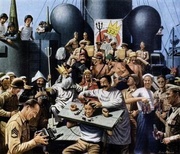
It has come to our attention that our president lacks a yacht. That’s right: Donald J. Trump, who is so rich that our eyeballs would burn right out of their sockets if we so much as glimpsed his tax returns, is without a suitably luxurious means of floating on our nation’s great inland waterways or along its rocky shores. Our commander-in-chief reportedly owns a Boeing 757, a Cessna Citation X, a trio of helicopters, a pair of Rolls Royces, a Lamborghini Diablo, and a custom-made, gold-trimmed motorcycle from Orange County Choppers. But when it comes to watercraft, President Trump is up that proverbial creek without so much as a paddle.
“Roosevelt was a martini guy. A good cocktail was very important to him.”
Once upon a time, we the people supplied our presidents with a floating getaway. Leaders as politically dissimilar as Herbert Hoover and Jimmy Carter cruised aboard the 104-foot USS Sequoia, as did presidents Kennedy through Ford, while Truman and Eisenhower enjoyed the Williamsburg.
But the most famous and storied presidential yacht is the USS Potomac, which was a favorite escape for President Franklin D. Roosevelt from 1936 until his death in 1945. Since 1981, the Potomac has been berthed in Oakland, California. In 1995, it opened to the public for tours and excursions on San Francisco Bay.

Top: In 1939, President Roosevelt (at center, holding the arm of a naval officer for support) entertained King George VI of England (to FDR’s right) aboard the Potomac. Also present were Queen Elizabeth and Eleanor Roosevelt (both to the King’s right). (Image by Harris & Ewing, via Wikimedia Commons) Above: The Potomac at its berth in Oakland, California. (Image by Christopher J. Wood via Wikimedia Commons)
Few know as much about the Potomac’s history as Les Dropkin, a retired actuary who has been an active volunteer with the nonprofit Potomac Association for more than 20 years. “The ship and I are contemporaries,” Dropkin says. “Growing up, FDR was the only president I knew.”
For people of Dropkin’s generation, the Potomac is a tangible link to Roosevelt, widely considered the greatest U.S. president of the modern era. For many more, the Potomac is a symbol of a time when America was united at home and abroad, weathering the Great Depression and winning World War II, albeit at the expense of Japanese Americans who were incarcerated during the conflict.
Recently, Dropkin explained the history of the Potomac during a guided tour of the vessel, which goes into dry dock later this year for $350,000-worth of Coast Guard-mandated inspections and repairs. “The Potomac started its life as the Electra,” Dropkin begins, “one of 18 cutters built for the Coast Guard between 1931 and 1934.” When the first of these cutters were launched, Dropkin says, Prohibition was still the law of the land, so the 165-foot-long vessels were used as patrol boats designed to intercept bootleggers, primarily close to shore and on rivers such as the Hudson and Potomac. “By 1934, when the Electra was built,” he continues, “Prohibition had ended, but there was still a lot of smuggling by those who wanted to avoid the taxes on liquor.”

President Franklin Roosevelt aboard the USS Potomac, 1936. (Image via Yachts International)
Ships like the Electra earned their keep by foiling such tax cheats, but the Electra did this virtuous work for only a few months before it was selected, in 1935, to be President Roosevelt’s official yacht. “During the first years of his administration,” Dropkin says, “Roosevelt used a Department of Commerce vessel called the Sequoia as his presidential yacht.” President Hoover had sailed on the Sequoia, too, but only after Roosevelt’s election, during the final months of 1932. Upon taking office, Roosevelt, who enjoyed being on the water more than his predecessor, took to the Sequoia whenever his busy schedule would allow.
Hoover and Roosevelt were not the first presidents to enjoy such treatment. According to Dropkin, the idea of a presidential yacht took shape in the latter part of the 19th century. “As commander-in-chief,” Dropkin says, “a president can board any naval vessel he chooses. But in the 19th century, the idea evolved of perhaps having a naval vessel available for use by high government officials. Gradually, that narrowed to a vessel specifically for the president.”
The Sequoia, though, was not a perfect yacht for a head of state. “The Sequoia was only 104 feet long,” Dropkin explains. That meant the president’s Secret Service detail had to follow behind in a separate ship. At 165 feet in length, the Electra, when converted, would have room for two cabins for the Secret Service.

Roosevelt’s chief of staff, Missy LeHand, conferring with the president aboard the Potomac in 1939. (Image via the National Register of Historic Places)
Fire was another concern. “The Sequoia was a wood-hulled vessel—those in charge of Roosevelt’s safety wanted a ship made out of steel. So the president tasked his naval aide with the mission of finding a replacement vessel. Working with the Navy Department, the aide and his staff found four ships in the government’s fleet that might serve Roosevelt’s purposes. A list was presented to FDR and he selected the Electra, renaming it the Potomac.”
Using an existing Coast Guard cutter made economic sense—the Depression was no time for extravagance, even for a new president. But there was another reason why Roosevelt got the Potomac with its steel hull and room for onboard Secret Service officers. A polio victim since 1921, the 53-year-old president required a wheelchair to get around, so if a fire broke out on the short-staffed Sequoia, Roosevelt’s life would almost certainly be in danger.
Once the ship was selected, work began almost immediately to make the Potomac fit for a president. Some of these changes would have served any commander-in-chief, disabled or not. “From about the midships passageway forward,” Dropkin tells me as we stand on the dock in Oakland’s Jack London Square, “she looks very much as she did when she was a Coast Guard cutter. But from the midships passageway on back, that’s where the real changes occurred, the things that made her into the presidential yacht.”

The Potomac‘s rear smokestack was converted into an elevator so the wheelchair-bound president could move freely between the ship’s two main decks.
The biggest change was to install a spacious, shaded aft deck, where Roosevelt could work or entertain while enjoying river or ocean breezes. “When the ship was a Coast Guard cutter, this deck did not exist,” Dropkin says, as we walk across its teak surface, “but it was a favorite area of the president.” That’s probably because the seating on the deck was designed with the wheelchair-bound Roosevelt in mind. Dropkin points to an upholstered settee that follows the curve of the ship’s stern. “It’s about 4 feet deep in the middle,” he says, “to support the president’s legs, something for him to stretch out on. You can almost imagine him sitting there, drink in hand.
“Roosevelt was a martini guy,” Dropkin continues. “A good cocktail was very important to him. He had started having cocktail hour when he was governor of New York, and brought the practice with him to the White House. His wife, Eleanor, wasn’t crazy about that, but they were different people.”
Other changes to the Electra that were more particular to Roosevelt included the removal of the floor coamings designed to contain water that might be sloshing on deck. For example, the low barrier was removed between the main dining room and the presidential bedroom, so that Roosevelt could get himself between the two spaces in his wheelchair. Even more dramatic was the conversion of one of the ship’s two smokestacks into an elevator, allowing the president to move freely between to ship’s two main decks. “An elevator was built into what had been the rear smokestack,” Dropkin says. “It’s an electric elevator now, but when the president used it, it was literally just a platform roped to a pulley. He would pull himself up, or let himself down, arm over arm. Roosevelt was very strong, and always wanted to do things for himself.”

In 1964, Elvis Presley, seen here with entertainer Danny Thomas, purchased the Potomac and donated it to Saint Jude’s Hospital, which promptly sold it. (Image via the Potomac Association)
Often the Potomac was treated as a sort of floating White House. In August 1941, it even ferried the president part of the way to a secret meeting with British Prime Minister Winston Churchill prior to the U.S. involvement in World War II. However, Dropkin says the most typical use of the ship by FDR was for weekend fishing cruises. “They’d board at the Washington, D.C., Navy Yard on, say, Saturday morning and sail down the Potomac River into Chesapeake Bay. Then, they’d find a nice cove, anchor, and spend the weekend fishing.”
Along for the ride was what Dropkin characterizes as “a very, very large crew. There were 42 enlisted men, 12 stewards, and three officers,” he says. “If you count up the number of available bunks and divide, you’ll see it doesn’t add up. So they had what are called hot bunks, to put it in naval terms. When one sailor was on duty, another would sleep. Basically, they’d take turns.”
If the Potomac was initially known for its famous, presidential passenger, after FDR’s death, in 1945, it would eventually become infamous. From 1946 until 1960, the ship was used by the Maryland Tidewater Fisheries Commission, and occasionally by that state’s governor. After that, though, it would begin a slow decline. In 1960, the Potomac was sold and pressed into service as a ferry in the Caribbean, until a different entrepreneur got the bright idea of sailing the ship through the Panama Canal to show her off at the 1962 Seattle World’s Fair. The aging vessel got as far as Southern California, where it languished until 1964, when it was purchased by Elvis Presley at an auction. Apparently, The King shelled out the $55,000 hammer price because he didn’t like the idea of seeing FDR’s yacht chopped into pieces for scrap, but never really want to own the Potomac, so he promptly donated the ship to the Saint Jude Hospital of Memphis, which just as promptly sold it to the first in a series of dreamers and schemers.

In 1981, the Potomac sank in 35 feet of water while docked at the Treasure Island Naval Base in San Francisco Bay. (Image by U.S. Customs, via the Potomac Association)
By August of 1980, the Potomac would be towed for repairs to Pier 26 in San Francisco, where, the following month, it was seized by U.S. Customs and the Drug Enforcement Agency. Although drugs were never found aboard the Potomac, a ship owned by the same owner and anchored alongside the Potomac was loaded with contraband. According to Dropkin’s history of this dark moment in the Potomac’s past, a Southern California drug ring had been using the Potomac’s good name, and a fake charity called “The Crippled Children’s Society,” as a front. That October, the Potomac was towed again, this time to the nearby Treasure Island Naval Base in San Francisco Bay where, the following March, its hull was punctured by broken pilings, causing it to sink in 35 feet of water.
The story might have ended there, but once the ship was raised and the hole in its hull was patched, the Potomac was purchased in April of 1981 at yet another auction. This time, the new owner was the Port of Oakland, whose winning bid of $15,000 was also the only bid. But the port’s then-executive director, Walter Abernathy, saw the Potomac as an opportunity for the community and historians alike. Shortly after taking possession of the ship, the port authorized “$400,000 in seed money to restore the ship to its appearance during the Roosevelt era and operate it as a historical and educational resource.” By 1983, the Potomac Association had incorporated to manage the ship’s upkeep and programs, and elected FDR’s oldest son, James, as its chairman. Finally, in 1985, a sitting president, Ronald Reagan, got involved, personally recommending a $2.5 million grant for the ship’s restoration. The grant was approved and matched, and in 1990, the Potomac was designated a National Historical Landmark.

For more than two decades, Les Dropkin has been a tireless volunteer for the Potomac Association.
As we walk through the Potomac, Dropkin explains the limits of a restoration project for a vessel that had seen decades of neglect before sinking. “There’s very little that’s original from the FDR era on the ship today,” he says. “Essentially, everything you see is a re-creation.”
In an effort to get the details right, the restorers carefully studied photographs of the ship during its FDR days, from the furniture to the draperies. And because there were records of the ship’s original construction and subsequent retrofit for the president, the Potomac Association was able to replicate its construction techniques. “When the Electra was built as a Coast Guard cutter, it was a riveted ship,” Dropkin says. “But when it was converted to become the presidential yacht, they had started to use welding. In the restoration, we maintained the ratios—what was welded was re-welded, where there had been rivets we used rivets. A very major concern in the restoration was to make it historically accurate to the fullest extent we could.”
Today, such attention to detail, as well as the $350,000 needed to pay for the Potomac’s upcoming drydocking, might seem like a luxury the country can’t afford in the face of multi-trillion-dollar deficits. But is $350,000 really all that much to honor the memory of one of our nation’s greatest presidents? After all, we are spending about half that amount every single day to protect our current president’s latest wife, who has chosen not to live in the White House with her husband, at least until their 10-year-old son finishes the school year. Naturally, most parents will be sympathetic with that decision, if not the expense. By comparison, $350,000 to help us remember the man who told a fearful nation that the only thing it had to fear was fear itself, and then proceeded to lead the fight against Adolf Hitler, seems like a rather good deal.
(If you would like to help keep FDR’s yacht shipshape, visit the Potomac Association)

 400 Years of Equator Hazings: Surviving the Stinky Wrath of King Neptune's Court
400 Years of Equator Hazings: Surviving the Stinky Wrath of King Neptune's Court
 Hello Sailor! The Nautical Roots of Popular Tattoos
Hello Sailor! The Nautical Roots of Popular Tattoos 400 Years of Equator Hazings: Surviving the Stinky Wrath of King Neptune's Court
400 Years of Equator Hazings: Surviving the Stinky Wrath of King Neptune's Court Capturing a Generation of Aviation Geniuses and Their Incredible Flying Machines
Capturing a Generation of Aviation Geniuses and Their Incredible Flying Machines Boat and Ship PostcardsThere’s just something romantic about picturing yourself on the high seas, …
Boat and Ship PostcardsThere’s just something romantic about picturing yourself on the high seas, … Roosevelt MemorabiliaFor collectors of political memorabilia, the word “Roosevelt” can refer to …
Roosevelt MemorabiliaFor collectors of political memorabilia, the word “Roosevelt” can refer to … Mari Tepper: Laying it on the Line
Mari Tepper: Laying it on the Line Nice Ice: Valerie Hammond on the Genteel Charm of Vintage Canadian Costume Jewelry
Nice Ice: Valerie Hammond on the Genteel Charm of Vintage Canadian Costume Jewelry How Jim Heimann Got Crazy for California Architecture
How Jim Heimann Got Crazy for California Architecture Modernist Man: Jock Peters May Be the Most Influential Architect You've Never Heard Of
Modernist Man: Jock Peters May Be the Most Influential Architect You've Never Heard Of Meet Cute: Were Kokeshi Dolls the Models for Hello Kitty, Pokemon, and Be@rbrick?
Meet Cute: Were Kokeshi Dolls the Models for Hello Kitty, Pokemon, and Be@rbrick? When the King of Comedy Posters Set His Surreal Sights on the World of Rock 'n' Roll
When the King of Comedy Posters Set His Surreal Sights on the World of Rock 'n' Roll How One Artist Makes New Art From Old Coloring Books and Found Photos
How One Artist Makes New Art From Old Coloring Books and Found Photos Say Cheese! How Bad Photography Has Changed Our Definition of Good Pictures
Say Cheese! How Bad Photography Has Changed Our Definition of Good Pictures Middle Earthenware: One Family's Quest to Reclaim Its Place in British Pottery History
Middle Earthenware: One Family's Quest to Reclaim Its Place in British Pottery History Fancy Fowl: How an Evil Sea Captain and a Beloved Queen Made the World Crave KFC
Fancy Fowl: How an Evil Sea Captain and a Beloved Queen Made the World Crave KFC
At the very end of an otherwise entertaining article, Ben just couldn’t resist taking a cheap shot at the very charming and elegant Mrs. Trump.
As Mr. Marks illustrates, Trump Derangement Syndrome is a horrible disease.
Mr. Marks’ comment about federal expenditures is very timely and appropriate. At a time when we are spending about a million dollars a day to cover the new president’s own travel and family security expenses (including three golfing vacations during his first month in office), 8 hours’ worth of that security and travel to help restore the Potomac, a National Historic Landmark, seems well justified. A very nice article.
Mr Dodsworth, the charming and elegant Mrs Trump is costing the city of New York somewhat around $1,ooo,ooo a DAY for police coverage for each day she chooses to reside not in the White House but at Trump Tower. That is over and above the expense for Secret Service coverage for EIGHTEEN Trump family members. Mr Mark’s innocuous comment was hardly a cheap shot, but perhaps you would enjoy some dip for the chip on your shoulder.